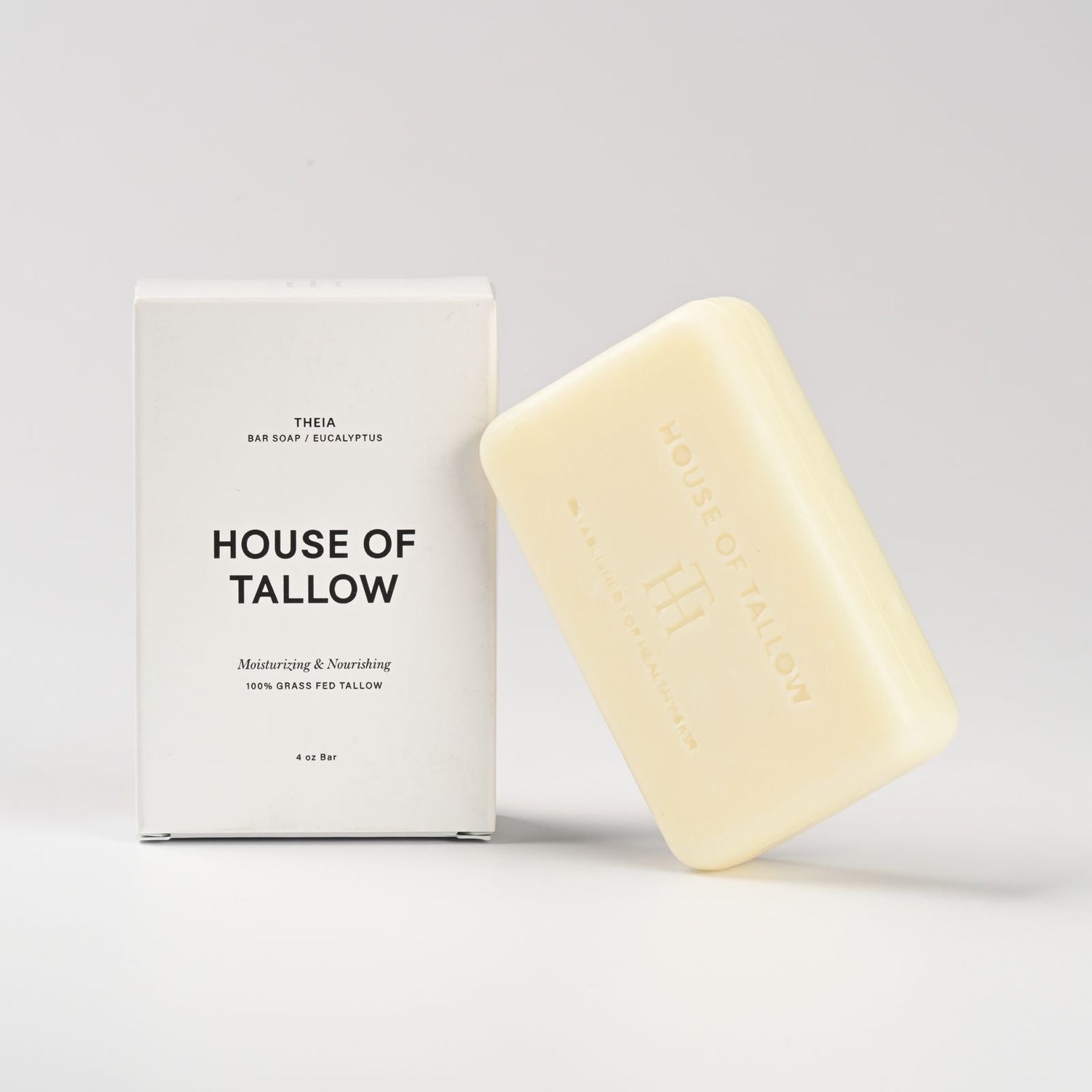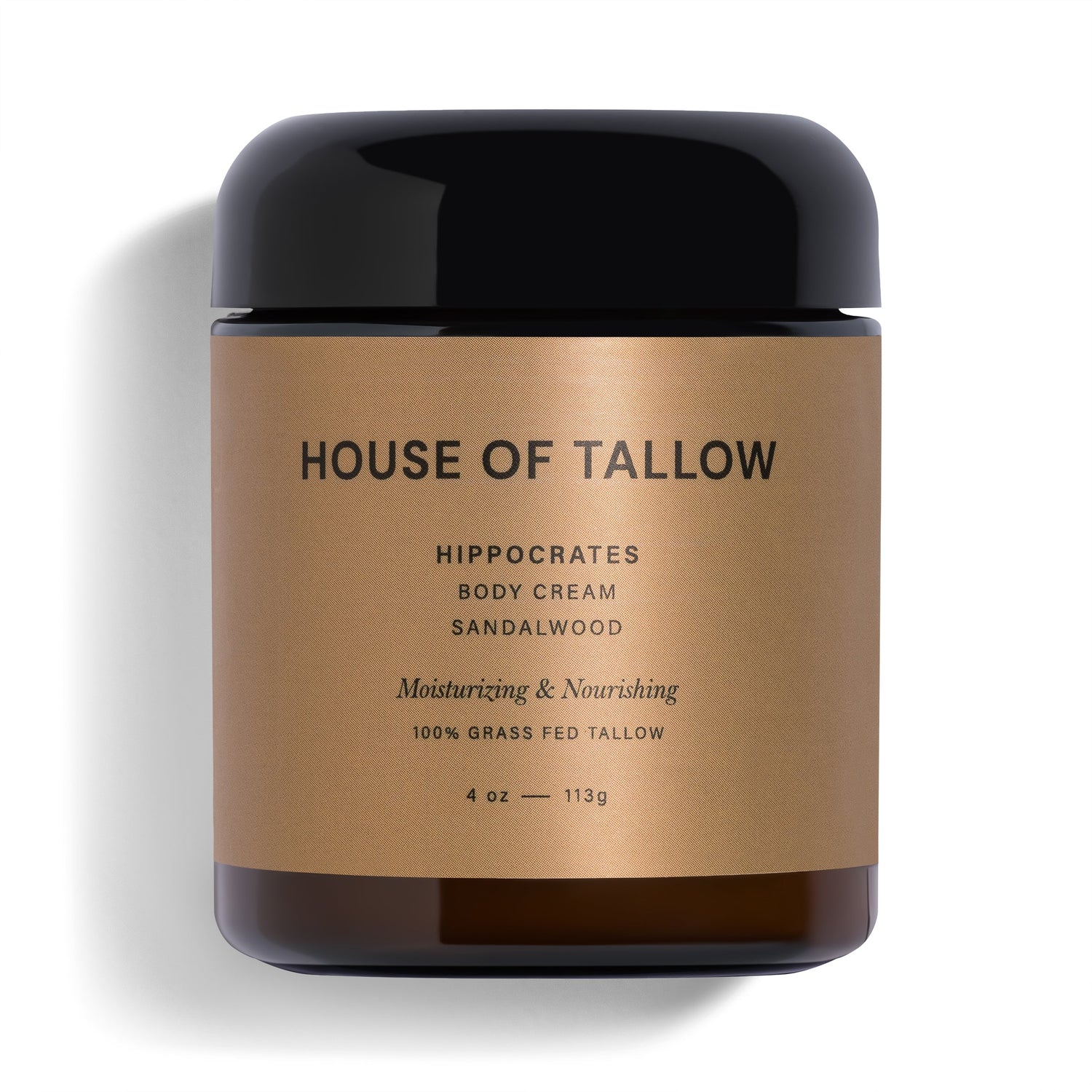Tallow is becoming popular in skincare again, especially for sensitive skin. Here's what you need to know:
- Pros: Tallow is rich in vitamins (A, D, E, K) and fatty acids that mimic human skin oils, providing deep hydration and supporting the skin barrier. Grass-fed tallow is the best choice for sensitive skin.
- Cons: It can clog pores (comedogenic) and may cause breakouts for oily or acne-prone skin. Allergic reactions and sun sensitivity are also possible.
- Alternatives: If tallow doesn’t work for you, try plant-based options like shea butter, hyaluronic acid, or squalene, which are less likely to irritate sensitive skin.
Quick Tip: Always patch test tallow-based products before full use. Look for unscented, high-quality, grass-fed options for the best results.
Safety of Tallow for Sensitive Skin
How Tallow Helps Sensitive Skin
Tallow contains about 55% saturated fats, closely resembling the fatty acid profile of human sebum. This similarity allows it to blend seamlessly with the skin's natural barrier, providing deep hydration while maintaining its protective function.
The natural fatty acids in tallow help support the skin's barrier and deliver nutrients. Grass-fed tallow, in particular, contains Conjugated Linoleic Acid (CLA), which helps keep the skin moisturized and supports elasticity.
"Love the option of a No Scent Tallow! Nothing is so 'natural' and leaves so much softness as the 'most like my own skin' feel of tallow." – Barbara Starke
While these benefits are appealing, it’s important to be aware of potential concerns.
Common Risks and Reactions
"Beef tallow is comedogenic, which means it can clog pores. I recommend that patients with oily, acne-prone skin stay away from beef tallow to avoid increasing breakouts".
There are some risks to consider when using tallow:
| Risk Factor | Potential Impact | Prevention |
|---|---|---|
| Quality Issues | Risk of bacterial growth if not stored properly | Choose trusted brands and follow storage guidelines |
| Comedogenic Effects | May clog pores for some skin types | Apply sparingly and test on a small area first |
| Sun Sensitivity | Could increase sensitivity to sunlight | Always use sunscreen when applying tallow products |
| Allergic Reactions | Possible irritation for some users | Stop use immediately if irritation occurs |
By following proper precautions, many of these risks can be minimized.
Grass-Fed Tallow Quality Standards
The quality of tallow plays a big role in its safety for sensitive skin. Grass-fed tallow contains a higher concentration of beneficial compounds compared to conventional options. Brands like House of Tallow ensure their products meet strict standards.
The safest tallow products come from grass-fed, regeneratively raised cattle. They are carefully refined, properly stored, and tested by third parties for purity. High-quality tallow also tends to score low (around 2) on the comedogenic scale, making it a good option for most sensitive skin types when used appropriately.
Tallow vs Other Skin Moisturizers
Tallow's Main Benefits
Tallow is different from many conventional moisturizers because its molecular structure is very similar to human sebum. This allows it to deeply hydrate the skin and provide long-lasting moisture. It’s also packed with fat-soluble vitamins and nutrients that can help maintain healthy skin.
Here’s how it compares to other popular moisturizers:
| Moisturizer Type | Benefits | Drawbacks |
|---|---|---|
| Tallow | Deeply penetrates, works well with skin, rich in vitamins | – |
| Shea Butter | High in fatty acids and vitamins A and E; soothing properties | – |
| Coconut Oil | Creates a protective layer on the skin | May clog pores (comedogenic) |
| Synthetic Moisturizers | Quick hydration | Effects can fade quickly; may include irritants |
Next, let’s explore situations where other options might work better.
When to Choose Other Options
While tallow has plenty of benefits, there are times when other moisturizers might be more suitable. For example, plant-based options are often better for oily or combination skin, and those with sensitive skin may prefer products like the unscented Gaia cream from House of Tallow.
You might want to consider alternatives in these cases:
- Daytime Use: Lightweight, fast-absorbing moisturizers are ideal for wearing under makeup or during daily activities.
- Targeted Skin Concerns: Some skin conditions may require specialized treatments that tallow doesn’t address.
- Dietary Preferences: If you follow a vegan or vegetarian lifestyle, plant-based moisturizers are a more suitable choice.
Many people use tallow as a rich, intensive moisturizer at night while opting for lighter products during the day to meet their skin’s diverse needs.
How to Use Tallow on Sensitive Skin
Patch Testing Steps
Before using tallow on your face or body, it's important to do a patch test first:
- Pick a Spot: Apply a small amount of tallow to a hidden area, like the inside of your arm or the crease of your elbow.
- Apply and Wait: Use the product as you normally would. For leave-on products, let it sit on your skin. For rinse-off products, leave it for about 5 minutes before washing it off.
- Monitor for Reactions: Repeat this process twice a day for 7–10 days. If irritation occurs, wash it off immediately. You can soothe the area with a cool compress or a bit of petroleum jelly.
If no irritation shows up, you’re good to move on to full application.
Proper Application Techniques
Once you've confirmed your skin tolerates tallow, follow these steps for the best results:
- Apply a small, pea-sized amount to damp skin after cleansing or showering.
- If the tallow feels firm, warm it between your hands first.
- Use gentle upward strokes to spread it evenly.
- For nighttime routines, layer it over a toner or hydrosol. Let your skin absorb it completely before adding other products.
What to Watch For
Pay attention to how your skin reacts. Some signs that tallow might not work for you include:
- Immediate reactions: Redness, itching, burning, or small bumps/hives.
- Later reactions: Clogged pores, breakouts, extra oiliness, dryness, or peeling.
If you notice any of these, rinse with cool water and stop using the product. Tallow products often have a pH of 9–10, which may not suit very sensitive skin. Keeping an eye on your skin after each use will help ensure tallow works as a safe and nourishing option for you.
sbb-itb-a1b9fc0
Who Should Not Use Tallow
Problem Skin Conditions
While tallow works well for some, it can make certain skin issues worse. Dr. Teresa Song explains:
"It is probably better tolerated for dry skin and should be avoided in those with sensitive skin, combination, acne and oily skin types due to potential worsening of breakouts."
Here are the skin types that might experience problems:
- Acne-Prone Skin: The high oleic acid content could clog pores.
- Oily Skin: It may trap bacteria, leading to more breakouts.
- Active Rosacea: Tallow could worsen inflammation.
- Combination Skin: There's a higher chance of breakouts.
If your skin is very sensitive and tallow isn't a good fit, there are other effective options available.
Options for Very Sensitive Skin
For those with sensitive skin, alternatives like hyaluronic acid, squalene, ceramides, and shea butter can provide hydration without the risks associated with tallow:
| Alternative | Benefits | Best For |
|---|---|---|
| Hyaluronic Acid | Hydrates deeply without feeling greasy | All skin types |
| Squalene | Lightweight and stable moisturizer | Combination skin |
| Ceramides | Helps repair and protect the skin barrier | Very sensitive skin |
| Shea Butter | Natural option with extended shelf life | Dry, sensitive skin |
These options are more stable than tallow and less likely to cause irritation. Always consult a dermatologist before making changes to your skincare routine.
Why Is Everyone Putting Beef Tallow On Their Skin?
Making the Right Choice for Your Skin
Grass-fed tallow contains up to four times more Vitamin E compared to conventional sources. This higher vitamin content, combined with its natural fatty acids, makes it a strong option for supporting skin health. To pick the best product for your sensitive skin, pay attention to these quality indicators:
| Quality Indicator | Why It Matters | What to Look For |
|---|---|---|
| Source | Influences vitamin levels | 100% grass-fed and finished cattle |
| Processing | Affects purity | Dry-rendered, purified tallow |
| Additives | Can cause irritation | Free from fragrances or preservatives |
| Testing | Ensures safety | Clear instructions for patch testing |
Experts weigh in on the topic:
"While beef tallow is rich in fatty acids, is very occlusive, and offers emollient benefits, there are better-studied plant-based fats with fewer variables in terms of quality and safety."
If you’re interested in trying tallow-based skincare, start with unscented products specifically made for sensitive skin. One option is House of Tallow's Gaia Unscented Body Cream ($29.99), which has received positive feedback. Elita Krums-Kane shared her experience:
"Gaia's Unscented Tallow Body Cream is an exceptional product that delivers unparalleled moisture and nourishment to the skin. As someone with sensitive skin, I am always cautious about the products I use, but Gaia's cream exceeded my expectations."
Make sure to perform a patch test as outlined earlier. If your skin reacts well, you can slowly increase usage. However, if irritation occurs or you have one of the skin types mentioned in earlier sections, consider trying alternative moisturizers or consult a dermatologist for tailored advice.




